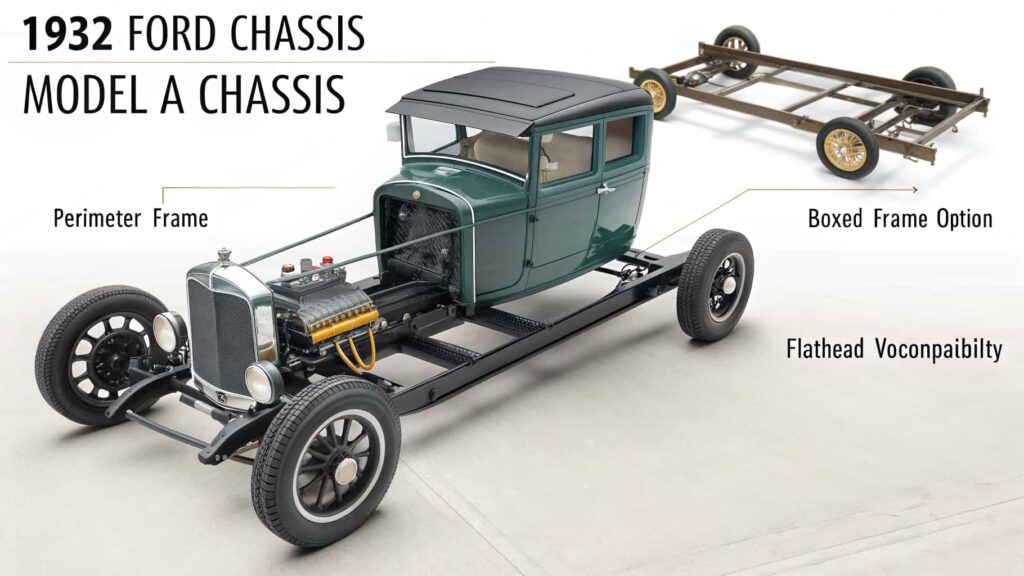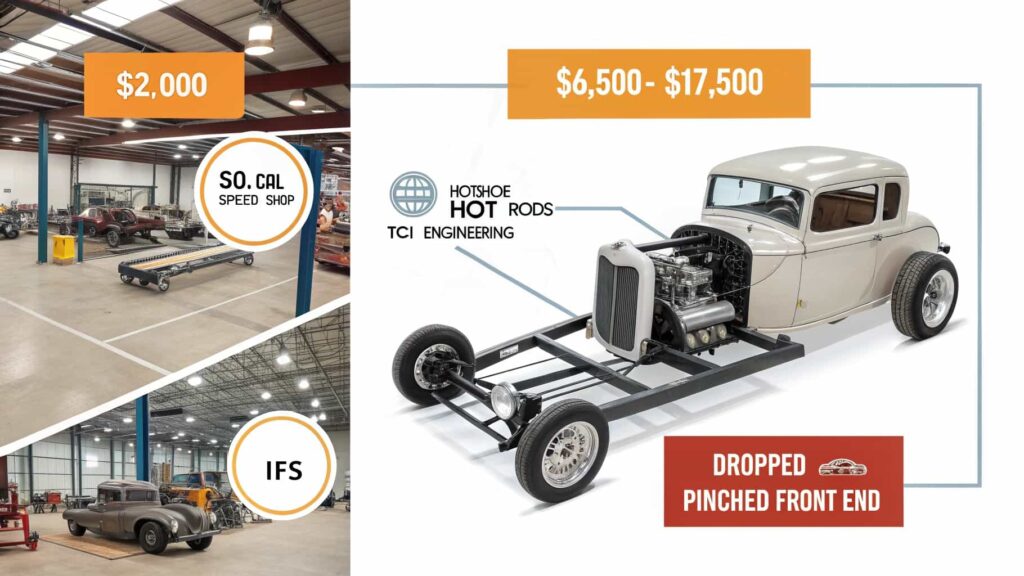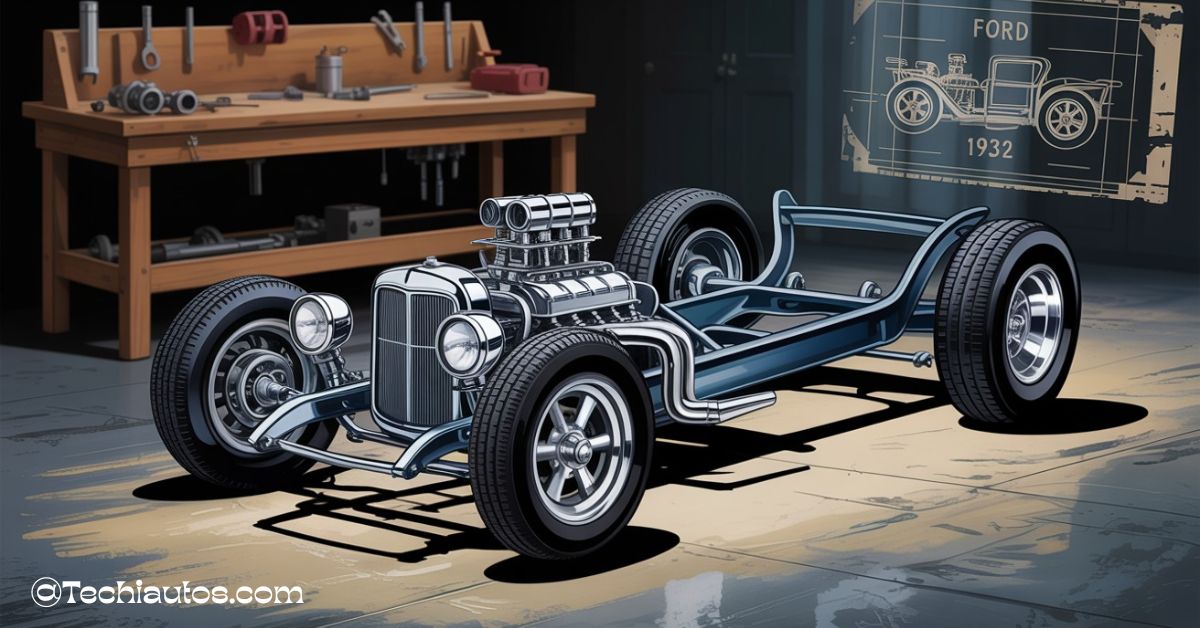The 1932 Ford chassis features a strong, double-dropped frame that supports both four-cylinder and V8 engines. It’s famous for its low stance and classic style, making it a top choice for hot rods and custom builds. This chassis remains iconic in car culture today.
Stay tuned with us as we dive deeper into everything about the 1932 Ford chassis, from its history to building tips and upgrades!
Introduction
The 1932 Ford chassis is the frame that supported Ford’s famous 1932 car models — the Model B, Model 18, and Model 40. These cars marked a major step in Ford’s design. Before 1932, Ford used straight rails in their frames. But in this year, they introduced a new frame with a double-dropped design. It gave the car a lower stance and better style.
The Model B used a four-cylinder engine, and the Model 18 was the first mass-produced car with a V8 engine. The V8 power and the new 1932 Ford chassis made it a favorite among speed enthusiasts. The Model 40 followed later that year, featuring additional improvements.
Over time, the 1932 Ford chassis became a legend in the world of custom cars. Builders and racers saw it as the perfect base for hot rods and street rods. Its shape, strength, and easy fit with other parts made it a popular choice. Even today, many car fans still use the 1932 Ford chassis for building dream cars. It stands as one of the most loved frames in car history.
Chassis Evolution & Technical Overview

The 1932 Ford chassis marked a turning point in Ford’s design history. It was the first to support two engine types — the flathead V8 in the Model 18 and the four-cylinder in the Model B. This change in engine size and weight directly affected how the frame was built. The V8 needed more strength and better balance, and the 1932 Ford chassis handled that need ideally.
One of the most significant updates was the frame design. Earlier models, like the Model A, used straight frame rails. But the 1932 Ford chassis introduced double-dropped, curved rails. This new shape gave the car a lower ride height, which improved looks and handling. It also made the frame more solid and better for custom builds.
Another key feature was the option between perimeter frames and boxed frames. A perimeter frame runs along the outer edge of the body, offering a clean and simple design. A boxed frame is stronger, with closed sections that give extra support. Builders often prefer boxed frames for high-performance hot rods and street rods.
These changes made the 1932 Ford chassis a strong, reliable, and stylish platform — one that still holds value in the car world today.
Chassis Variants & Configurations
The 1932 Ford chassis came in several forms, each offering different options for builders and collectors. The factory chassis types included the basic perimeter frame, which followed the body’s outer shape. Some builders use pinched frames, where the front rails are narrowed to better fit custom bodies. There are also step-boxed frames, which add extra strength to certain sections, and complete rolling chassis, which come with wheels, suspension, and other parts already installed.
Over time, many hot rod builders started using aftermarket setups to improve handling and ride quality. Popular upgrades include independent front suspension (IFS), which provides smoother steering and improved control. Builders also use the classic dropped steel axle for a lower front end. Some prefer modern kits, such as Heidt’s or Mustang II IFS, which add modern performance to the vintage look of the 1932 Ford chassis.
Several companies now offer complete chassis packages. For example, Hotshoe Hot Rods sells complete rolling chassis between $10,500 and $12,000, depending on the features. These come with the frame, suspension, brakes, and mounts. TCI Engineering offers a variety of IFS chassis with pricing based on the setup, and they often include a strong warranty to back their products.
These choices give builders the freedom to go with an original style or upgrade the 1932 Ford chassis into a full-performance machine.
Building & Upgrading Considerations
When working with a 1932 Ford chassis, one of the first decisions is whether to build it yourself (DIY) or buy a turnkey frame that’s ready to go. A DIY chassis usually starts with stamped boxed rails or a fully welded perimeter frame. This route offers more control but requires time, skill, and specialized tools. On the other hand, a turnkey chassis is pre-assembled, often with suspension, brakes, and mounts already in place, making it perfect for builders who want to save time and get straight to the body work.
There are many upgrade options available to improve safety, performance, and ride quality. Popular upgrades include front disc brakes for better stopping power, coil-overs for smoother suspension, and panhard bars to keep the axle centered. Some builders also add cross steering for better handling and power brakes for easier pedal control.
Customization is also a big part of working with the 1932 Ford chassis. One of the most critical decisions is body fitment. Some builders opt for a pinched nose, where the front of the frame is narrowed to accommodate custom or fiberglass bodies. Others decide between building a Hi-Boy (with no fenders, exposing the wheels) or a full-fender car (giving it a classic factory look). Each choice changes the final style and feel of the vehicle.
These build and upgrade options are what make the 1932 Ford chassis such a favorite—it’s strong, flexible, and easy to shape into something truly unique.
Chassis Brands & Specialists
When selecting a 1932 Ford chassis, it’s essential to be aware of the top brands available on the market. Trusted manufacturers include Hotshoe Hot Rods, SO CAL Speed Shop, Blackboard Hotrods, RJays, and TCI Engineering. These companies are renowned for crafting high-quality frames that complement both traditional and modern builds. Each one offers different features, options, and price points to fit various project needs.
Prices for a 1932 Ford chassis can vary depending on the specific features you’re purchasing. Basic boxed rails—just the main frame rails without extra parts—usually cost between $895 and $1,800. These are good for builders who want to handle assembly themselves. On the higher end, a fully rolling chassis, which includes the frame, suspension, brakes, and mounts, can range from $6,500 to $17,500. These are ready for body mounting and save a lot of time.
Many of these frames come with special features that make the build easier. Some are numbered for tracking and resale. The boxing quality—how the frame is sealed and reinforced—is a key detail that affects strength and performance. Most frames also include transmission mounts that fit popular setups like TH350, 700R4, or even manuals.
Choosing the right brand and setup can make a huge difference in your build. With the wide range of quality and options available, there’s a perfect 1932 Ford chassis out there for every kind of project.
Technical Specs & Fitment
The 1932 Ford chassis is known for its balance of strength, size, and style. One popular reference point is the SO CAL Speed Shop frame, which measures 146 inches in length and 44 inches in width, with an average weight of approximately 200 pounds. This size makes it easy to handle during a build, while still being strong enough to support powerful engines and modern parts.
Transmission compatibility is a key detail when setting up your chassis. Most 1932 Ford chassis frames come with a cross-member that supports various transmission mounts. Builders often choose automatic options, such as the TH350 or 700R4, but many frames are also set up for manual transmissions. Selecting the correct cross member ensures a proper fit and smooth performance.
Brake and steering setups are another part of good fitment planning. Most upgraded frames include mounts for disc brakes, which are now the standard for safety and stopping power. Many also have tabs welded in for a panhard bar, which helps keep the axle centered, and steering stabilizer mounts, which reduce vibration and improve control.
These specs and fitment features are what make the 1932 Ford chassis easy to work with. Whether you’re building a cruiser or a performance car, having the right frame setup makes everything else fall into place.
Chassis in Builds & Culture
The 1932 Ford chassis holds a special place in the automotive world. One of the most famous examples is the “Deuce Flyer”, a clean and detailed hot rod that showcases just how smooth and firm this frame can be. These builds showcase the balance of old-school aesthetics and modern performance. There are also many videos online showing the body-meets-chassis process, where the frame and body are perfectly matched during final assembly. Watching this step gives new builders a clear view of how vital a solid frame is.
Beyond garage builds, the 1932 Ford chassis is deeply tied to hot rodding culture. It became a symbol of freedom and creativity. Songs like “Little Deuce Coupe” by The Beach Boys and movies like American Graffiti helped turn the 1932 Ford into a pop culture icon. Car enthusiasts saw it as the perfect starting point for building something fast, loud, and personal.
Buying & Building Tips

If you’re starting your project, knowing how to choose a chassis package is key. A factory-style chassis offers that classic look, while an aftermarket chassis gives more options for suspension and upgrades. Consider whether you prefer independent front suspension, a pinched front end, or a full rolling setup—your decision will impact how the car feels and looks.
Understanding the cost breakdown helps with planning. Basic frames can cost under $2,000, but a complete rolling chassis with brakes, mounts, and suspension can range from $6,500 to $17,500. Also, add costs for optional upgrades, such as coilovers, power brakes, and custom mounts. Don’t forget shipping fees, especially for fully assembled frames.
Finally, knowing where to buy makes things easier. Top vendors, such as Hotshoe Hot Rods, SO CAL Speed Shop, TCI Engineering, and RJays, all offer great packages. Some focus on traditional builds, others on modern performance. Select the vendor that aligns with your build goals.
The 1932 Ford chassis is more than just a frame—it’s the foundation of a true hot rod legend.
Installation & Assembly Guide
Getting your 1932 Ford chassis ready for the road starts with proper chassis prep. If you’re working from a basic frame, begin by boxing the rails to add strength, especially if you plan to run a V8 engine. Next, install the independent front suspension (IFS) or a dropped axle setup, depending on your build style. After that, mount the engine and transmission using the correct crossmember and brackets. Popular combos like the TH350 or 700R4 usually have dedicated mounting points on most aftermarket frames.
When it’s time for body fitment, make sure everything lines up cleanly. Some builders choose to pinch the front rails—this narrows the front section slightly to better match fiberglass or custom steel bodies. Use care when locating the body on the frame. Measure several times before drilling into bosses or frame tabs for final mounting. Good alignment here saves a lot of work later in the build.
Ultimately, proper alignment is crucial for ensuring safety and a smooth driving experience. Pay attention to steering box positioning, especially if you’re using a Vega or Mustang-style box. Make sure it’s placed at the correct angle and height. Set up a cross-steer system if your suspension requires it—this helps with precise, predictable handling and minimizes bump steer.
With careful prep, fitting, and alignment, your 1932 Ford chassis becomes the strong, reliable foundation every quality hot rod needs.
FAQ’s
1. How much is a 1932 Ford worth today?
A 1932 Ford’s value varies widely, ranging from $20,000 for a basic project to over $100,000 for fully restored or rare models.
2. What were the body types of Fords in 1932?
In 1932, Ford offered several body types including roadsters, coupes, sedans, phaetons, and pickups.
3. How do you tell if a Ford truck is a cab and chassis?
A cab and chassis truck has the cab installed but lacks a factory bed or body, showing an exposed frame behind the cab.
4. What is the Ford F53 chassis used for?
The Ford F53 chassis is commonly used for motorhomes, RVs, and commercial vehicles needing a strong, reliable platform.
Conclusion
The 1932 Ford chassis remains one of the most iconic and respected frames in automotive history. Its strong design, classic style, and versatility have made it the favorite choice for hot rodders and custom builders for nearly a century. Whether you want a traditional build or a modern street rod, this chassis offers the perfect foundation to bring your vision to life.
If you’re ready to start your project, now is the time to explore the many 1932 Ford chassis options available. From factory-style frames to fully loaded rolling chassis, there’s something for every skill level and budget. Get your build started today and join the long tradition of hot rodding excellence!
Also read:
- 1992 Ford F150 5.0 Oil Type: Complete Guide & Specs
- 1927 Ford T Roadster: Classic Style Meets Legacy!
